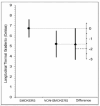Use of infrared thermography in patients undergoing primary amputation due to peripheral arterial obstructive disease
- PMID: 39607182
- PMCID: PMC11548873
- DOI: 10.1590/0100-6991e-20243733-en
Use of infrared thermography in patients undergoing primary amputation due to peripheral arterial obstructive disease
Abstract
Introduction: Peripheral Arterial Disease (PAD) is highly prevalent and the final stage of the disease is the Critical Ischemia (CI) of the Lower Limbs (LL), culminating, in most cases, with amputation of the limbs as part of the proposed treatment. Infrared Thermography (IT) is an inexpensive method, painless, without emission of radiation and easy to manage, which aims to determine the temperature of the skin of the limb to be amputated, and could help the surgeon to evaluate the level of the lower limb amputation.
Objective: To Evaluate Whether IT is a useful method to determine the level of lower limb amputation in patients with PAD and CI. Method: Prospective cohort study performed from April 2023 to November 2023, at the Unit of vascular surgery - Hospital de Base do Distrito Federal (Brasília-DF). It evaluated patients with PAD and CI that were in the preoperative period for lower limb amputation. All Patients Underwent IT evaluation standards protocols.
Results: The results showed a wider longitudinal thermal gradient in PAD smoking (S) patients compared to non-smokers. It was also observed that (S) patients with wide thermal gradients were more likely to undergo an above the knee amputation.
Conclusion: Infrared thermography was a useful method in discriminating thermal differences in patients with PAD and CI could be employed in preoperative evaluation to choose the level of lower limb amputation. Smoking patients with greater longitudinal thermal gradients are more likely to undergo an above the knee amputations.
Introdução:: A isquemia crítica (IC) dos membros inferiores (MMII) é o estágio final da Doença Arterial Obstrutiva Periférica (DAOP) e termina muitas vezes na amputação. A decisão do melhor nível de amputação frequentemente é baseada no julgamento clínico do médico cirurgião vascular. A Termografia Infravermelha (TI) é um método barato, indolor, sem emissão de radiação e de fácil manejo que pode determinar a temperatura da pele do membro a ser amputado, o que auxiliaria, assim, o cirurgião na escolha do melhor nível de amputação.
Objetivo:: Avaliar o uso da TI para escolha do nível da amputação em pacientes portadores de DAOP e IC dos MMII. Método: Estudo de Coorte Prospectivo, realizado no período de abril de 2023 a novembro de 2023, na Unidade de Cirurgia Vascular do Hospital de Base do Distrito Federal (Brasília-DF). O estudo incluiu pacientes com DAOP e IC dos MMII candidatos à amputação dos MMII. Todos foram submetidos à TI dos MMII utilizando protocolos padronizados com medidas térmicas em quatro áreas do membro inferior.
Resultados:: Os resultados evidenciaram um amplo gradiente térmico longitudinal em pacientes com DAOP e tabagistas (T) em comparação aos não tabagistas (NT). Os pacientes T com gradientes térmicos mais amplos apresentaram maior probabilidade de serem submetidos à uma amputação transfemoral.
Conclusão:: A termografia infravermelha é útil tanto em detectar diferenças térmicas em pacientes com DAOP e IC dos MMII, quanto na avaliação não invasiva pré-operatória destes doentes. Pacientes tabagistas com maiores gradientes térmicos longitudinais apresentam maior probabilidade de serem submetidos a amputações transfemorais.
Conflict of interest statement
Conflict of interest: no.
Figures


References
-
- Borges WR. Risk factors for amputation in patients with critical lower limb ischemia. J Vasc Bras. 2017;16(2):180–181. doi: 10.1590/1677-5449.003317. - DOI
MeSH terms
LinkOut - more resources
Full Text Sources
Medical
Miscellaneous

